On the Conceptual Design of Novel Supercritical CO2 Power Cycles for Waste Heat Recovery
Abstract
1. Introduction
1.1. The s-CO2 Power Cycle for Recovery of High Temperature Waste Heat
1.2. Traditional s-CO2 Power Cycles for WHR
1.3. Cascade of Two Traditional s-CO2 Power Cycles for WHR
1.4. Novel s-CO2 Power Cycles for WHR
1.5. Decomposition of Complex Plants into Elementary Thermodynamic Cycles
1.6. Aim and Main Novelty of This Work
2. Materials and Methods
2.1. Selection and Analysis of s-CO2 Power Cycles for WHR: Layouts and Decomposition into Elementary Thermodynamic Cycles
2.1.1. Single Flow Split with Dual Expansion s-CO2 Power Cycle
2.1.2. Partial Heating s-CO2 Power Cycle
2.1.3. Dual Recuperated s-CO2 Power Cycle
2.2. Modeling and Thermodynamic Optimization
2.2.1. Objective Function and Other Performance Metrics
2.2.2. Decision Variables and Main Assumptions
2.2.3. Thermal Efficiency of Elementary Thermodynamic Cycles
3. Results
3.1. Single Flow Split with Dual Expansion s-CO2 Power Cycle
3.2. Partial Heating s-CO2 Power Cycle
3.3. Dual Recuperated s-CO2 Power Cycle
3.4. Performance Comparison
3.5. Exergy-Based Performance Comparison
4. Discussion
Author Contributions
Funding
Conflicts of Interest
Nomenclature
| Acronyms | |
| C | Compressor |
| CL | Cooler |
| LT | Low temperature |
| LTR | Low temperature recuperator |
| LTT | Low temperature turbine |
| HT | Heater or high temperature |
| HTR | High temperature recuperator |
| HTT | High temperature turbine |
| REC | Recuperator |
| sCO2 | Supercritical CO2 |
| s-CO2 | Supercritical CO2 |
| T | Turbine |
| TIT | Turbine inlet temperature |
| WHR | Waste heat recovery |
| Parameters/Variables | |
| cp | specific heat, kJ/kg-K |
| m | mass flow rate, kg/s |
| mass flow rate, kg/s | |
| p | pressure, MPa |
| heat transfer rate, kW | |
| s | specific entropy, kJ/kg-K |
| x | mass fraction |
| T | temperature, °C |
| W | power, kW |
| power, kW | |
| Δ | difference |
| ε | recuperator effectiveness |
| efficiency, % | |
| heat recovery effectiveness | |
| Subscripts | |
| amb | ambient |
| av | available |
| C | compressor |
| hs | heat source |
| in | inlet |
| inter | intermediate |
| is | isentropic |
| m | mechanical |
| mg | mechanical/generator |
| min | minimum |
| net | net |
| opt | optimum |
| out | outlet |
| rec | recovered |
| T | turbine |
| th | thermal |
| TOT | total |
References
- Forman, C.; Muritala, I.K.; Pardemann, R.; Meyer, B. Estimating the global waste heat potential. Renew. Sustain. Energy Rev. 2016, 57, 1568–1579. [Google Scholar] [CrossRef]
- Papapetrou, M.; Kosmadakis, G.; Cipollina, A.; La Commare, U.; Micale, G. Industrial waste heat: Estimation of the technically available resource in the EU per industrial sector, temperature level and country. Appl. Therm. Eng. 2018, 138, 207–216. [Google Scholar] [CrossRef]
- Vance, D.; Nimbalkar, S.; Thekdi, A.; Armstrong, K.; Wenning, T.; Cresko, J.; Jin, M. Estimation of and barriers to waste heat recovery from harsh environments in industrial processes. J. Clean. Prod. 2019, 222, 539–549. [Google Scholar] [CrossRef]
- Firth, A.; Zhang, B.; Yang, A. Quantification of global waste heat and its environmental effects. Appl. Energy 2019, 235, 1314–1334. [Google Scholar] [CrossRef]
- Feher, E.G. The supercritical thermodynamic power cycle. Energy Convers. 1968, 8, 85–90. [Google Scholar] [CrossRef]
- Angelino, G. Carbon dioxide condensation cycles for power production. J. Eng. Power-Trans. AAME 1968, 90, 287–295. [Google Scholar] [CrossRef]
- Dostal, V.; Driscoll, M.J.; Hejzlar, P.A. A Supercritical Carbon Dioxide Cycle for Next Generation Nuclear Reactors; Massachusetts Institute of Technology: Cambridge, MA, USA, 2004. [Google Scholar]
- Mohagheghi, M.; Kapat, J. Thermodynamic optimization of recuperated s-CO2 Brayton cycles for waste heat recovery applications. In Proceedings of the 4th International Symposium on Supercritical CO2 Power Cycles, Pittsburgh, PA, USA, 9–10 September 2014. [Google Scholar]
- Khadse, A.; Blanchette, L.; Kapat, J.; Vasu, S.; Ahmed, K. Optimization of supercritical CO2 Brayton cycle for simple cycle gas turbines exhaust heat recovery using genetic algorithm. In Proceedings of the ASME Turbo Expo 2017: Turbomachinery Tech. Conf. and Exposition, Article No. 63696, Charlotte, NC, USA, 26–30 June 2017. [Google Scholar]
- Moroz, L.; Pagur, P.; Rudenko, O.; Burlaka, M.; Joly, C. Evaluation for scalability of a combined cycle using gas and bottoming sCO2 turbines. In Proceedings of the ASME Power & Energy, San Diego, CA, USA, 28 June–2 July 2015. [Google Scholar]
- Martínez, G.S.; Sánchez, D.; Crespi, F.; Gavagnin, G. A global approach to assessing the potential of combined cycles using supercritical technology. In Proceedings of the 1st Global Power and Propulsion Forum (GPPF), Zurich, Switzerland, 16–18 January 2017. [Google Scholar]
- Manente, G.; Lazzaretto, A. Innovative biomass to power conversion systems based on cascaded supercritical CO2 Brayton cycles. Biomass Bioenergy 2014, 69, 155–168. [Google Scholar] [CrossRef]
- Hou, S.; Wu, Y.; Zhou, Y.; Yu, L. Performance analysis of the combined supercritical CO2 recompression and recuperated cycle used in waste heat recovery of marine gas turbine. Energy Convers. Manag. 2017, 151, 73–85. [Google Scholar] [CrossRef]
- Zhang, Q.; Ogren, R.M.; Kong, S.-C. Thermo-economic analysis and multi-objective optimization of a novel waste heat recovery system with a transcritical CO2 cycle for offshore gas turbine application. Energy Convers. Manag. 2018, 172, 212–227. [Google Scholar] [CrossRef]
- Moroz, L.; Burlaka, M.; Rudenko, O.; Joly, C. Evaluation of gas turbine exhaust heat recovery utilizing composite supercritical CO2 cycle. In Proceedings of the International Gas Turbine Congress, Tokyo, Japan, 15–20 November 2015. [Google Scholar]
- Hou, S.; Zhou, Y.; Yu, L.; Zhang, F.; Cao, S. Optimization of the combined supercritical CO2 cycle and organic Rankine cycle using zeotropic mixtures for gas turbine waste heat recovery. Energy Convers. Manag. 2018, 160, 313–325. [Google Scholar] [CrossRef]
- Cao, Y.; Ren, J.; Sang, Y.; Dai, Y. Thermodynamic analysis and optimization of a gas turbine and cascade CO2 combined cycle. Energy Convers. Manag. 2017, 144, 193–204. [Google Scholar] [CrossRef]
- Kimzey, G. Development of a Brayton bottoming cycle using supercritical carbon dioxide as the working fluid. In A Report Submitted in Partial Fulfillment of the Requirements for: Gas Turbine Industrial Fellowship; University Turbine Systems Research Program: Palo Alto, CA, USA, 2012. [Google Scholar]
- Held, T. Waste Heat Recovery with Supercritical CO2 Cycles–Challenges and Opportunities; Technical presentation GT2012-70262 in the panel session “Application of Supercritical CO2 Cycles to Power Production”; ASME Turbo Expo: Copenhagen, Denmark, 11−15 June 2012. [Google Scholar]
- Walnum, H.T.; Nekså, P.; Nord, L.O.; Andresen, T. Modelling and simulation of CO2 (carbon dioxide) bottoming cycles for offshore oil and gas installations at design and off-design conditions. Energy 2013, 59, 513–520. [Google Scholar] [CrossRef]
- Held, T.J.; Vermeersch, M.L.; Xie, T.; Miller, J.D. Heat Engines With Cascade Cycles. World Patent WO/2011/119650 A2, 29 September 2011. [Google Scholar]
- Wright, S.A.; Davidson, C.S.; Scammell, W.O. Thermo-economic analysis of four sCO2 waste heat recovery power systems. In Proceedings of the 5th International Symposium on Supercritical CO2 Power Cycles, San Antonio, TX, USA, 29–31 March 2016. [Google Scholar]
- Cho, S.K.; Kim, M.; Baik, S.; Ahn, Y.; Lee, J.I. Investigation of the bottoming cycle for high efficiency combined cycle gas turbine system with supercritical carbon dioxide power cycle. In Proceedings of the ASME Turbo Expo 2015: Turbine Tech. Conf. and Exposition, Article No. 43077, Montréal, QC, Canada, 15–19 June 2015. [Google Scholar]
- Huck, P.; Freund, S.; Lehar, M.; Peter, M. Performance comparison of supercritical CO2 versus steam bottoming cycles for gas turbine combined cycle applications. In Proceedings of the 5th International Symposium on Supercritical CO2 Power Cycles, San Antonio, TX, USA, 29–31 March 2016. [Google Scholar]
- Kim, M.S.; Ahn, Y.; Kim, B.; Lee, J.I. Study on the supercritical CO2 power cycles for landfill gas firing gas turbine bottoming cycle. Energy 2016, 111, 893–909. [Google Scholar] [CrossRef]
- Kim, Y.M.; Sohn, J.L.; Yoon, E.S. Supercritical CO2 Rankine cycles for waste heat recovery from gas turbine. Energy 2017, 118, 893–905. [Google Scholar] [CrossRef]
- Marchionni, M.; Bianchi, G.; Tassou, S.A. Techno-economic assessment of Joule-Brayton cycle architectures for heat to power conversion from high-grade heat sources using CO2 in the supercritical state. Energy 2018, 148, 1140–1152. [Google Scholar] [CrossRef]
- Wu, C.; Yan, X.-J.; Wang, S.-S.; Bai, K.-L.; Di, J.; Cheng, S.-F.; Li, J. System optimisation and performance analysis of CO2 transcritical power cycle for waste heat recovery. Energy 2016, 100, 391–400. [Google Scholar] [CrossRef]
- Wang, S.-S.; Wu, C.; Li, J. Exergoeconomic analysis and optimization of single-pressure single stage and multi-stage CO2 transcritical power cycles for engine waste heat recovery: A comparative study. Energy 2018, 142, 559–577. [Google Scholar] [CrossRef]
- Astolfi, M.; Alfani, D.; Lasala, S.; Macchi, E. Comparison between ORC and CO2 power systems for the exploitation of low-medium temperature heat sources. Energy 2018, 161, 1250–1261. [Google Scholar] [CrossRef]
- Lazzaretto, A.; Toffolo, A. A method to separate the problem of heat transfer interactions in the synthesis of thermal systems. Energy 2008, 33, 163–170. [Google Scholar] [CrossRef]
- Lazzaretto, A.; Manente, G. Analysis of superimposed elementary thermodynamic cycles: From the Brayton-Joule to advanced mixed (auto-combined) cycles. Int. J. Thermodyn. 2009, 12, 123–130. [Google Scholar]
- Morandin, M.; Toffolo, A.; Lazzaretto, A. Superimposition of elementary thermodynamic cycles and separation of the heat transfer section in energy systems analysis. J. Energy Resour. Technol. 2013, 135, 021602. [Google Scholar] [CrossRef]
- Lazzaretto, A.; Manente, G.; Toffolo, A. SYNTHSEP: A general methodology for the synthesis of energy system configurations beyond superstructures. Energy 2018, 147, 924–949. [Google Scholar] [CrossRef]
- Toffolo, A. A synthesis/design optimization algorithm for Rankine cycle based energy systems. Energy 2014, 66, 115–127. [Google Scholar] [CrossRef]
- Manente, G.; Fortuna, F.M. Supercritical CO2 power cycles for waste heat recovery: A systematic comparison between traditional and novel layouts with dual expansion. Energy Convers. Manag. 2019, 197, 111777. [Google Scholar] [CrossRef]
- Vivian, J.; Manente, G.; Lazzaretto, A. A general framework to select working fluid and configuration of ORCs for low-to-medium temperature heat sources. Appl. Energy 2015, 156, 727–746. [Google Scholar] [CrossRef]
- Saravanamuttoo, H.I.H.; Rogers, G.F.C.; Cohen, H.; Straznicky, P.V.; Nix, A.C. Gas Turbine Theory, 7th ed.; Pearson Education Limited: Harlow, UK, 2017. [Google Scholar]
- Heywood, J.B. Internal Combustion Engine Fundamentals, 2nd ed.; McGraw-Hill Education: New York, NY, USA, 2018. [Google Scholar]
- Shiferaw, D.; Montero Carrero, J.; Le Pierres, R. Economic analysis of SCO2 cycles with PCHE Recuperator design optimization. In Proceedings of the 5th International Symposium on Supercritical CO2 Power Cycles, San Antonio, TX, USA, 28–31 March 2016. [Google Scholar]
- Naderi, C.; Rasouli, E.; Narayanan, V. Design and Performance Characterization of a Micro-pin fin sCO2 Recuperator. In Proceedings of the 6th International Symposium on Supercritical CO2 Power Cycles, Pittsburgh, PA, USA, 27–29 March 2018. [Google Scholar]
- Kemp, I.C. Pinch Analysis and Process Integration, 2nd ed.; Butterworth-Heinemann: London, UK, 2007. [Google Scholar]
- Rasouli, E.; Subedi, S.; Montgomery, C.; Mande, C.W.; Stevens, M.; Narayanan, V.; Rollett, A.D. Design and Performance Characterization of an Additively Manufactured Primary Heat Exchanger for sCO2 Waste Heat Recovery Cycles. In Proceedings of the 6th International Symposium on Supercritical CO2 Power Cycles, Pittsburgh, PA, USA, 27–29 March 2018. [Google Scholar]
- Cich, S.D.; Moore, J.; Mortzheim, J.P.; Hofer, D. Design of a supercritical CO2 compressor for use in a 10 MWe power cycle. In Proceedings of the 6th International Symposium on Supercritical CO2 Power Cycles, Pittsburgh, PA, USA, 27–29 March 2018. [Google Scholar]
- Wright, S.A.; Radel, R.F.; Vernon, M.E.; Rochau, G.E.; Pickard, P.S. Operation and Analysis of a Supercritical CO2 Brayton Cycle; Sandia Report, SAND2010-0171; Sandia National Laboratories: Springfield, VA, USA, 2010.
- Noall, J.S.; Pasch, J.J. Achievable Efficiency and Stability of Supercritical CO2 Compression Systems. In Proceedings of the 4th International Symposium on Supercritical CO2 Power Cycles, Pittsburgh, PA, USA, 9–10 September 2014. [Google Scholar]
- Zhou, K.; Wang, J.; Xia, J.; Guo, Y.; Zhao, P.; Dai, Y. Design and performance analysis of a supercritical CO2 radial inflow turbine. Appl. Therm. Eng. 2020, 167, 114757. [Google Scholar] [CrossRef]
- Zhou, A.; Li, X.-S.; Ren, X.-D.; Song, J.; Gu, C.-W. Thermodynamic and economic analysis of a supercritical carbon dioxide (S-CO2) recompression cycle with the radial-inflow turbine efficiency prediction. Energy 2019. in Press. [Google Scholar] [CrossRef]
- White, M.T.; Sayma, A.I. A preliminary comparison of different turbine architectures for a 100 kW supercritical CO2 Rankine cycle turbine. In Proceedings of the 6th International Symposium on Supercritical CO2 Power Cycles, Pittsburgh, PA, USA, 27–29 March 2018. [Google Scholar]
- Span, R.; Wagner, W. A New Equation of State for Carbon Dioxide Covering the Fluid Region from the Triple-Point Temperature to 1100 K at Pressures up to 800 MPa. J. Phys. Chem. Ref. Data 1996, 25, 1509–1596. [Google Scholar] [CrossRef]
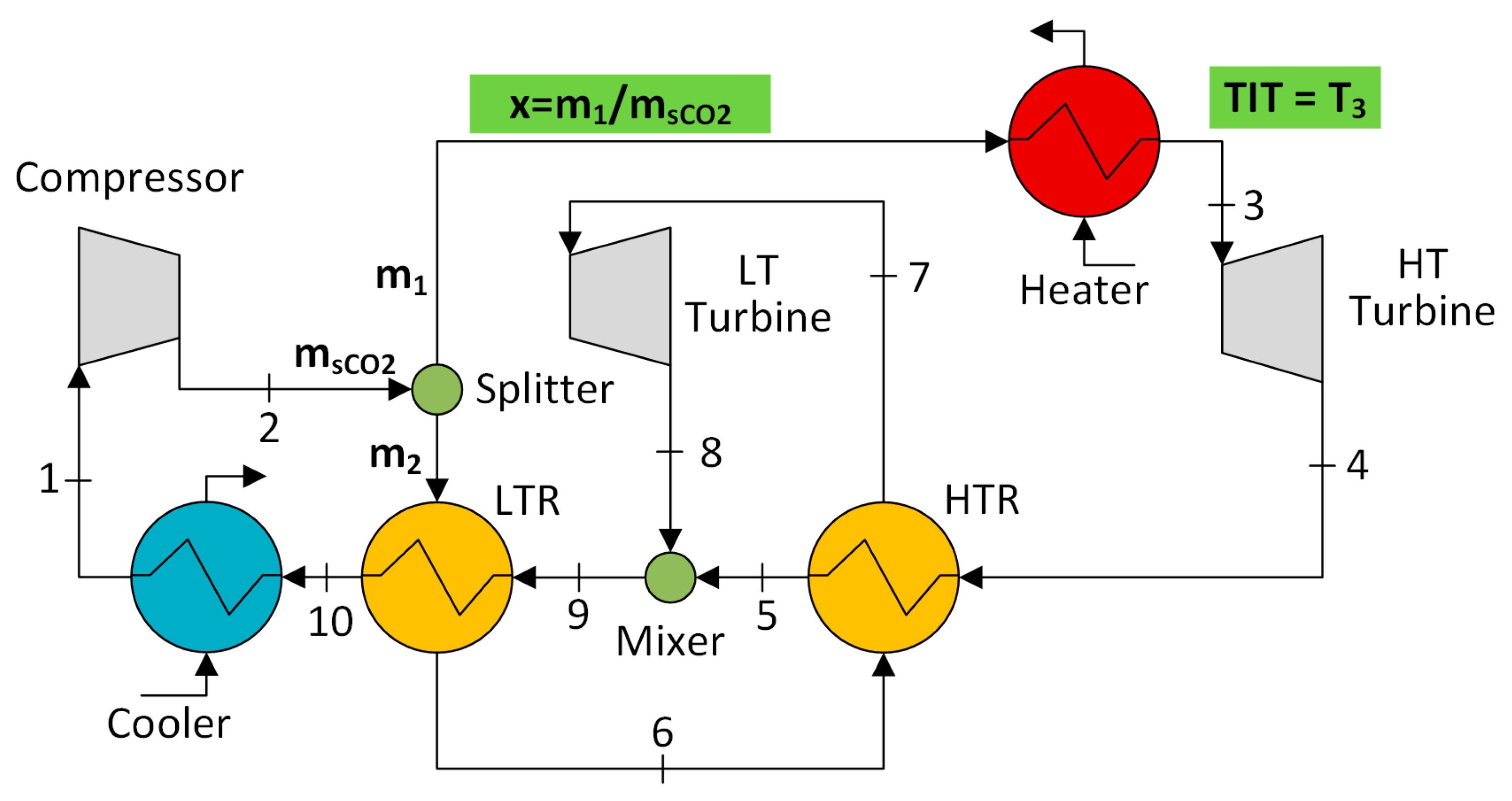

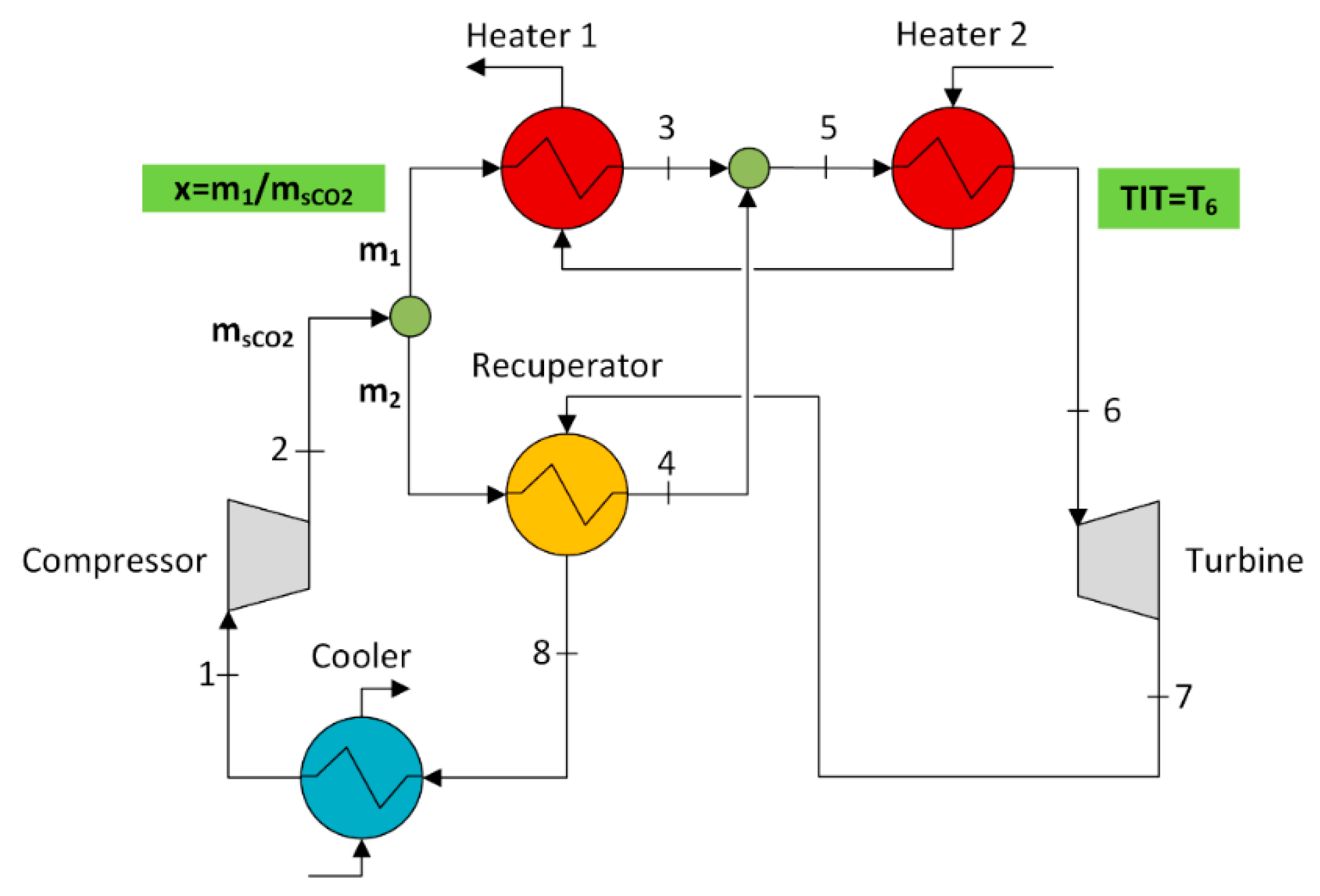
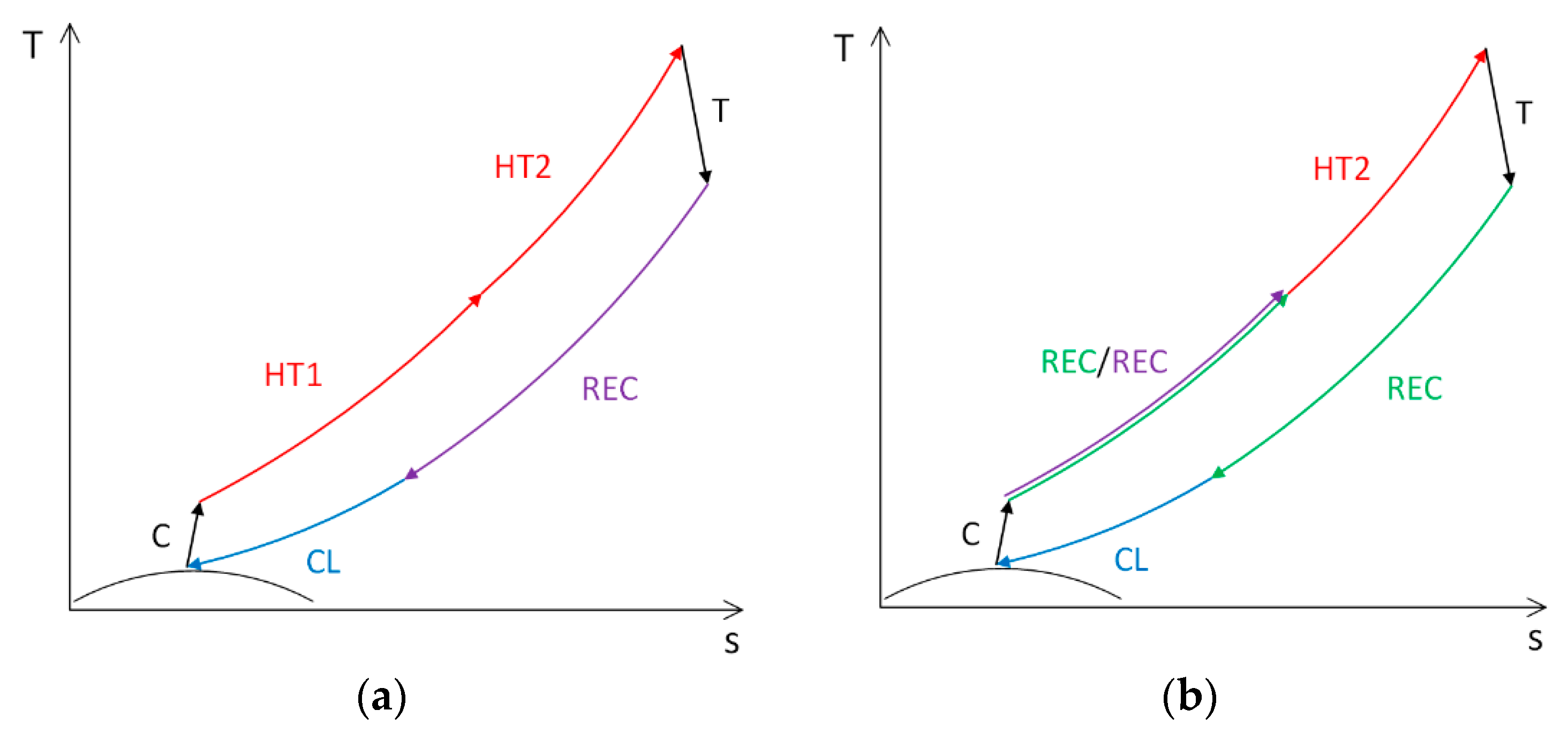
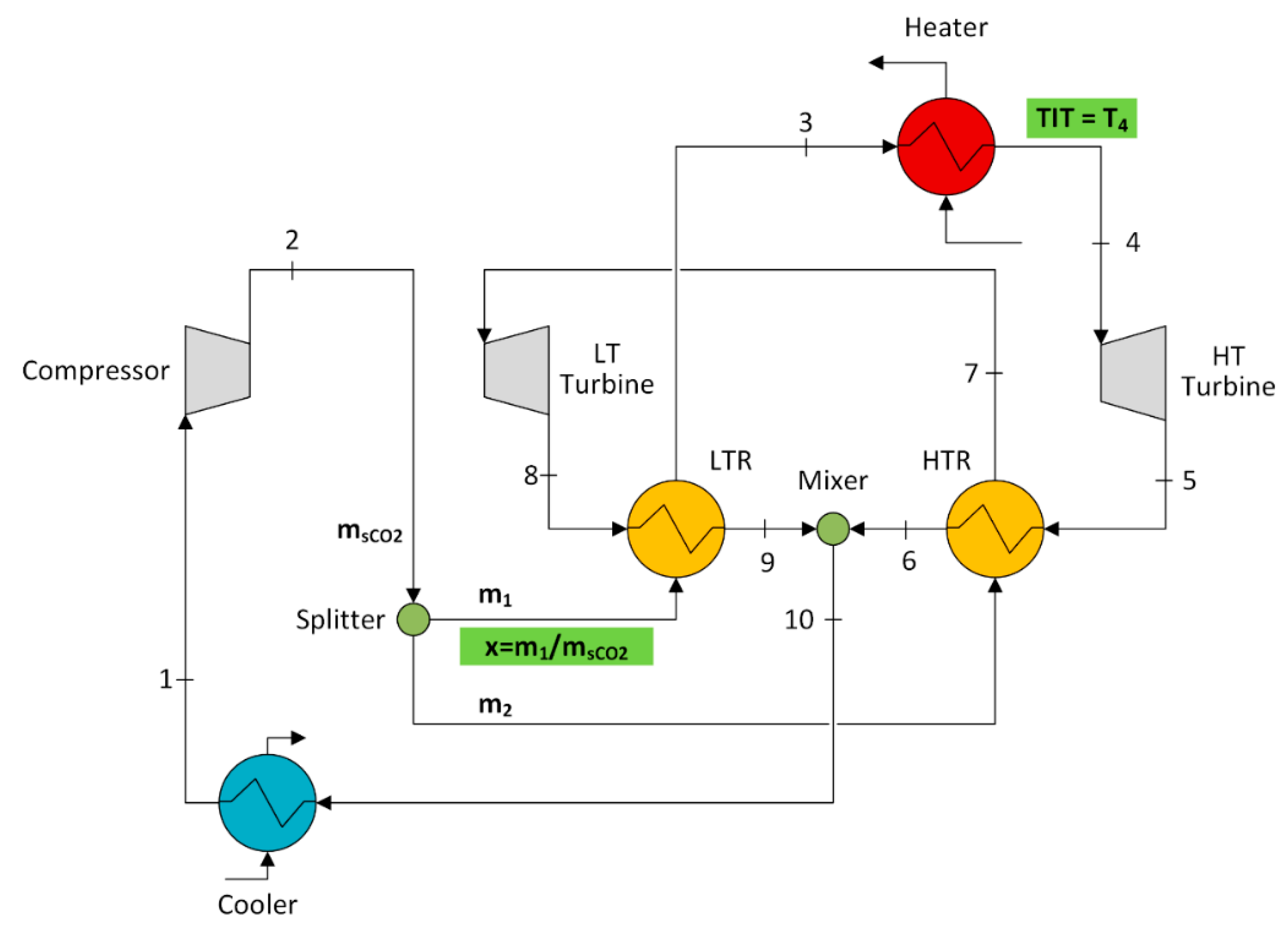
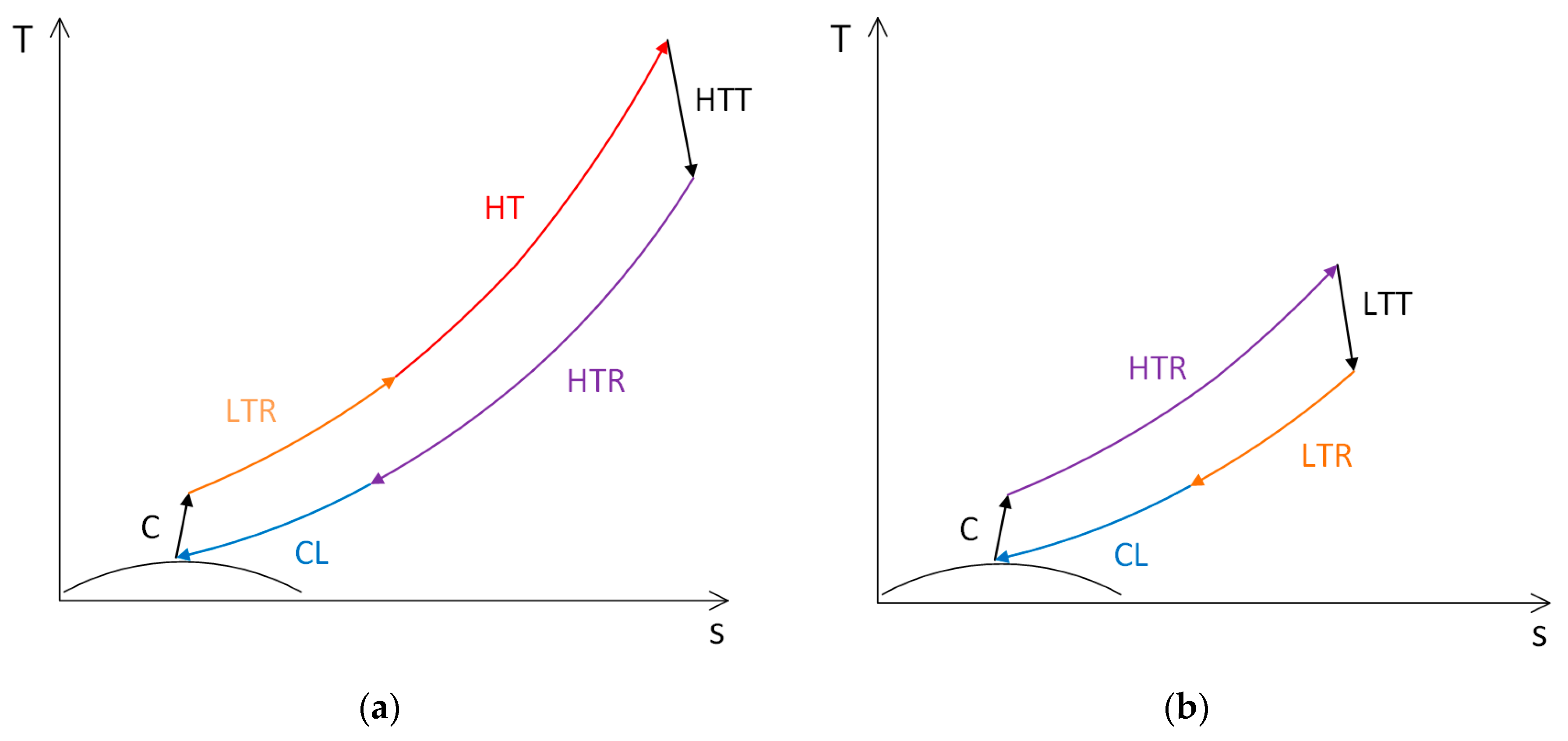
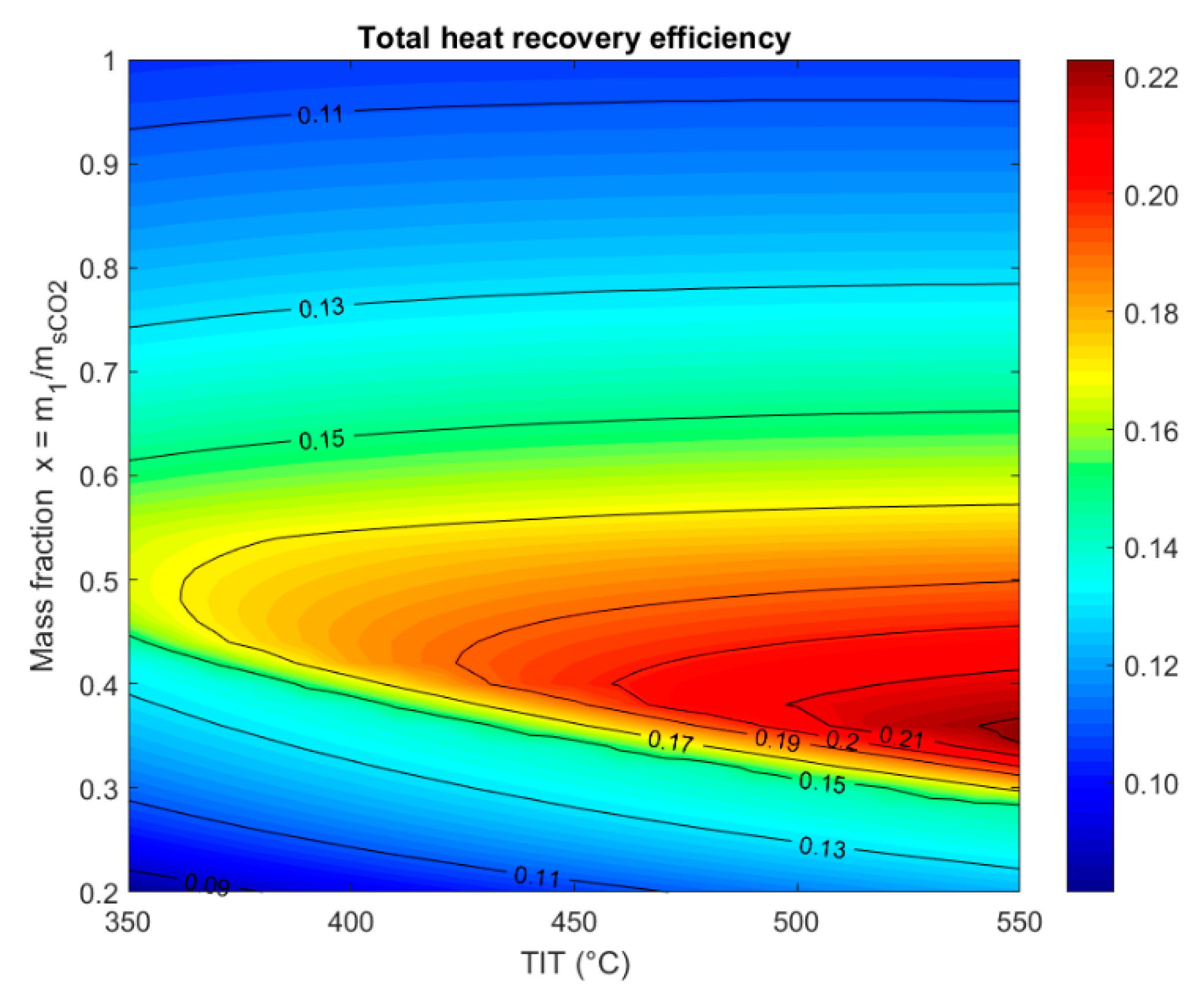
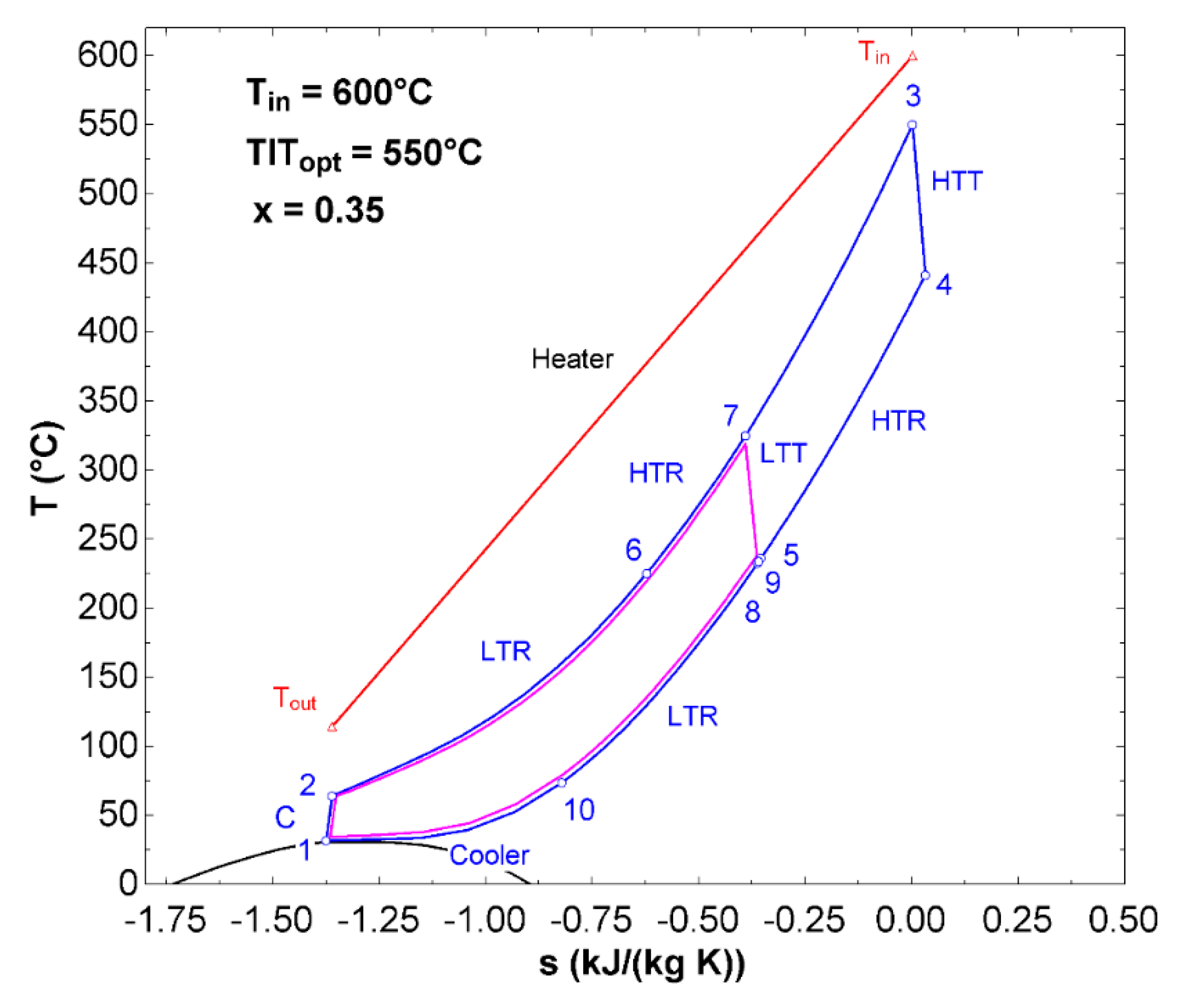
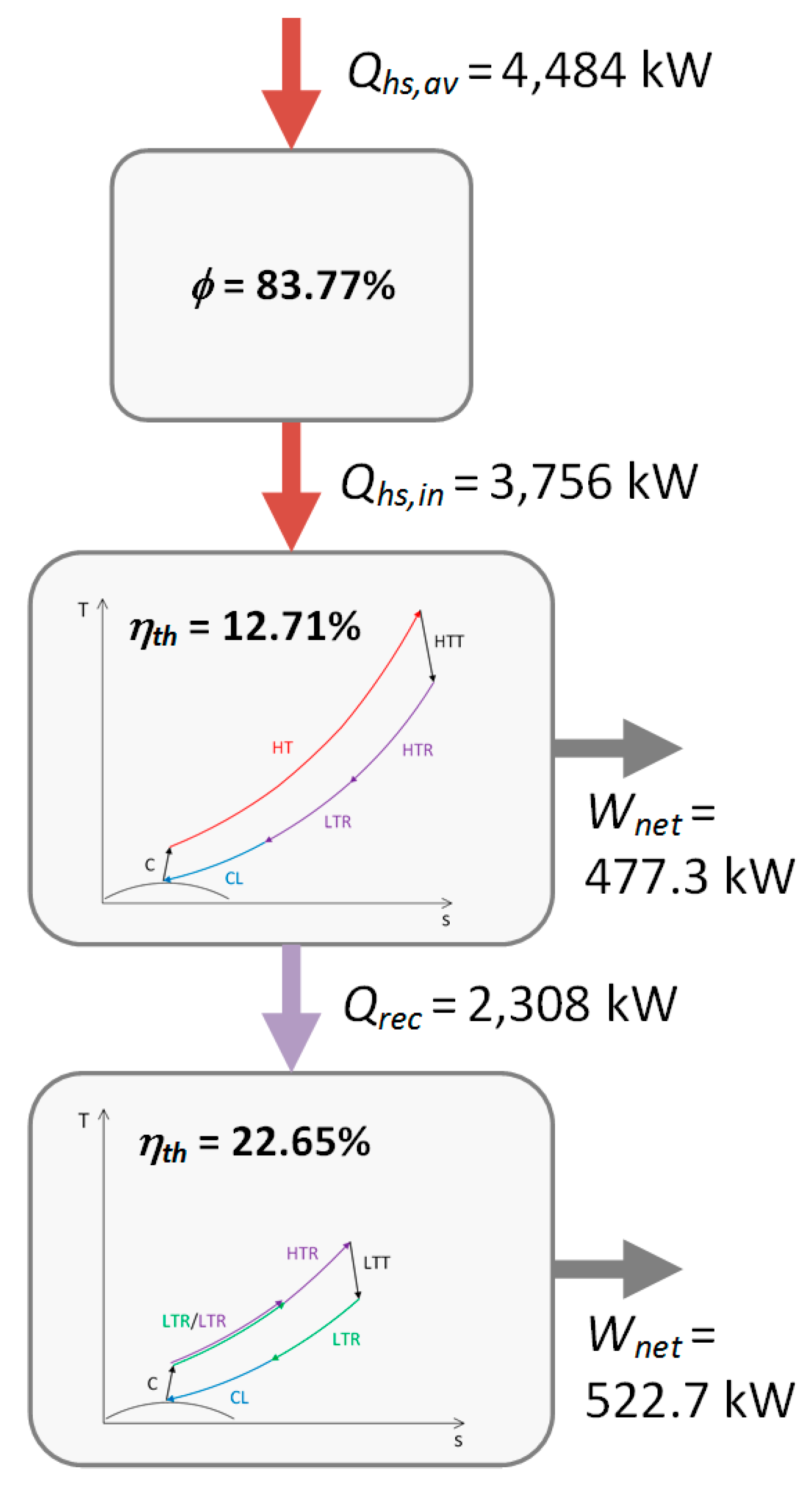
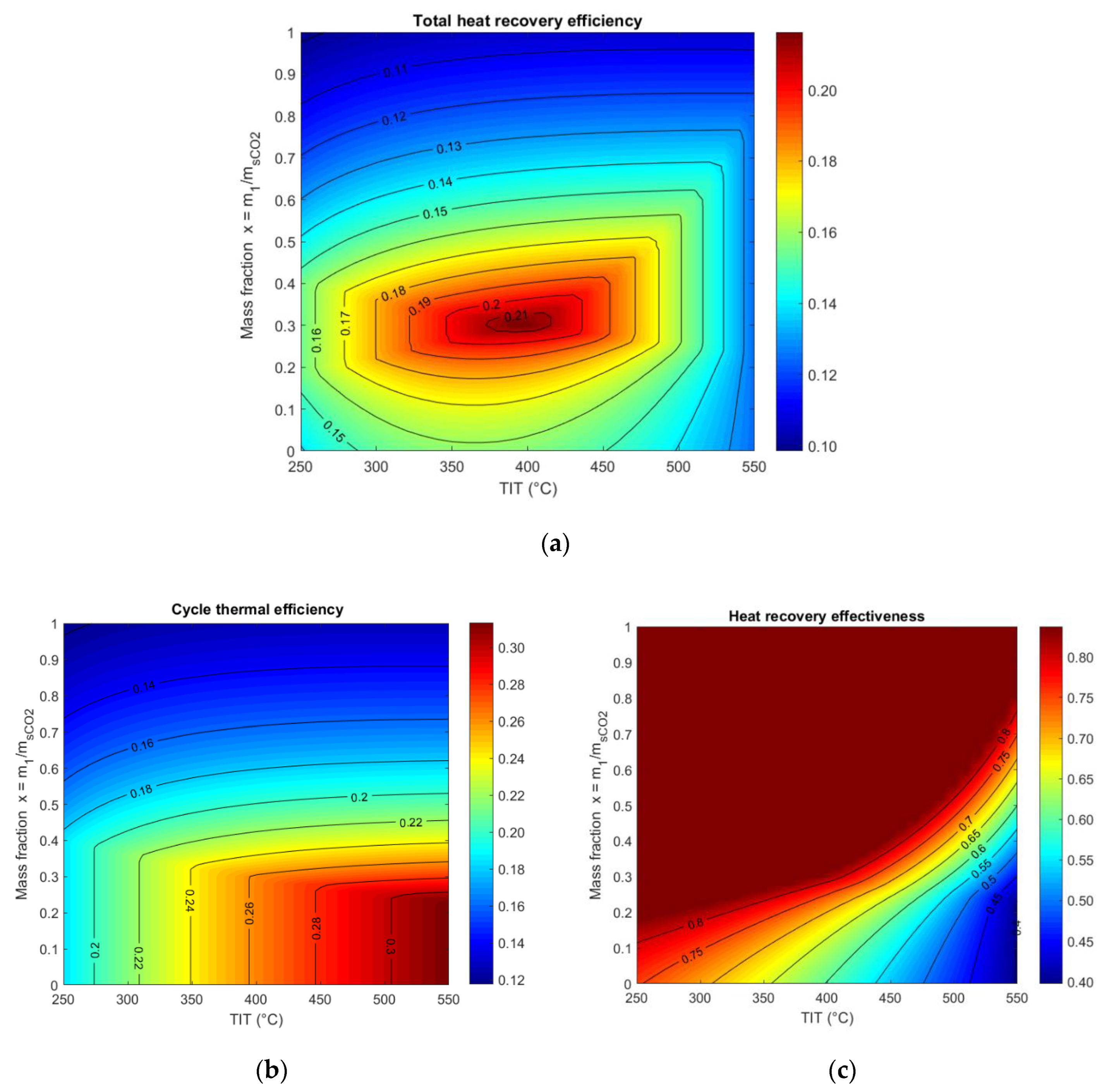

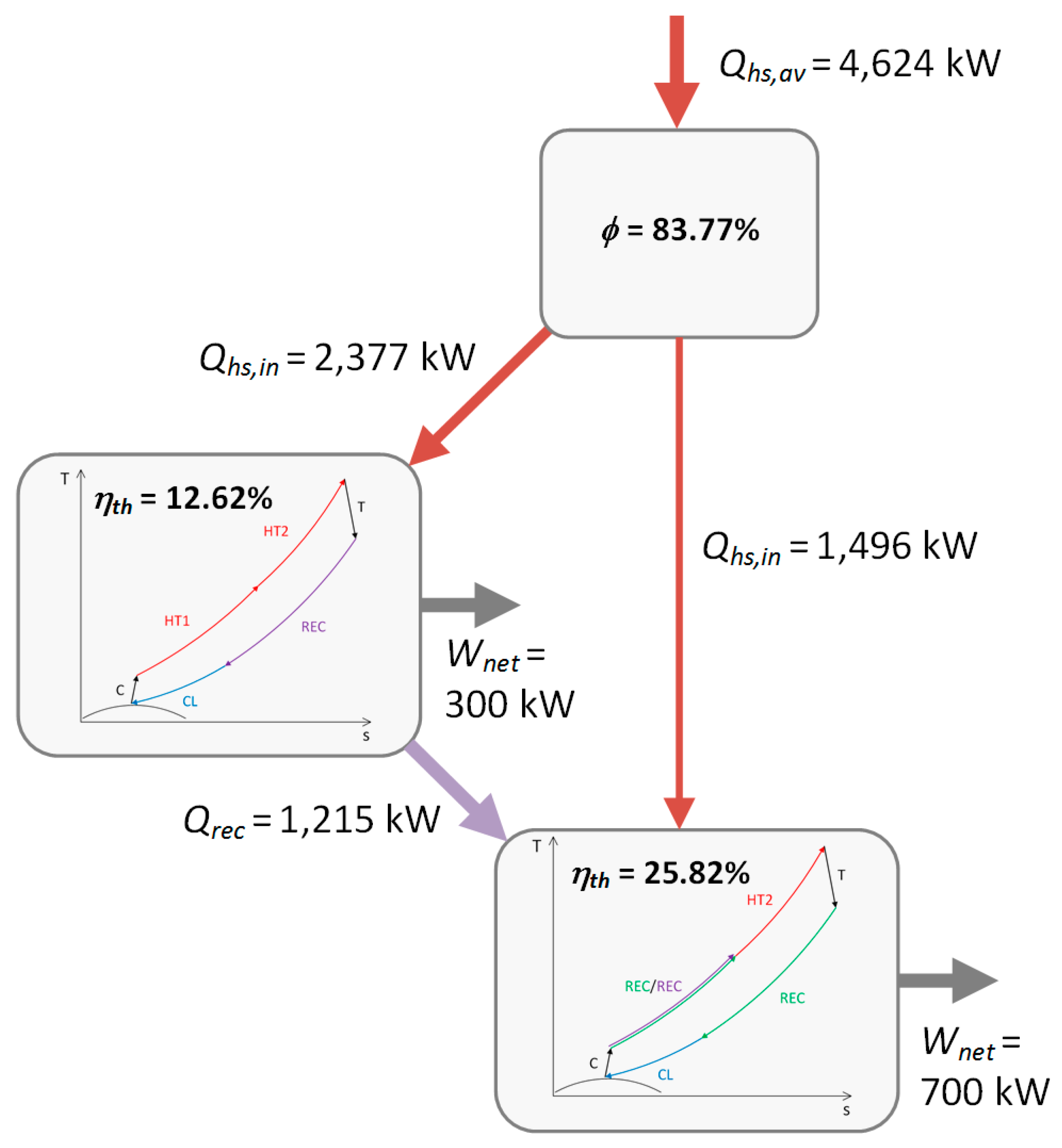
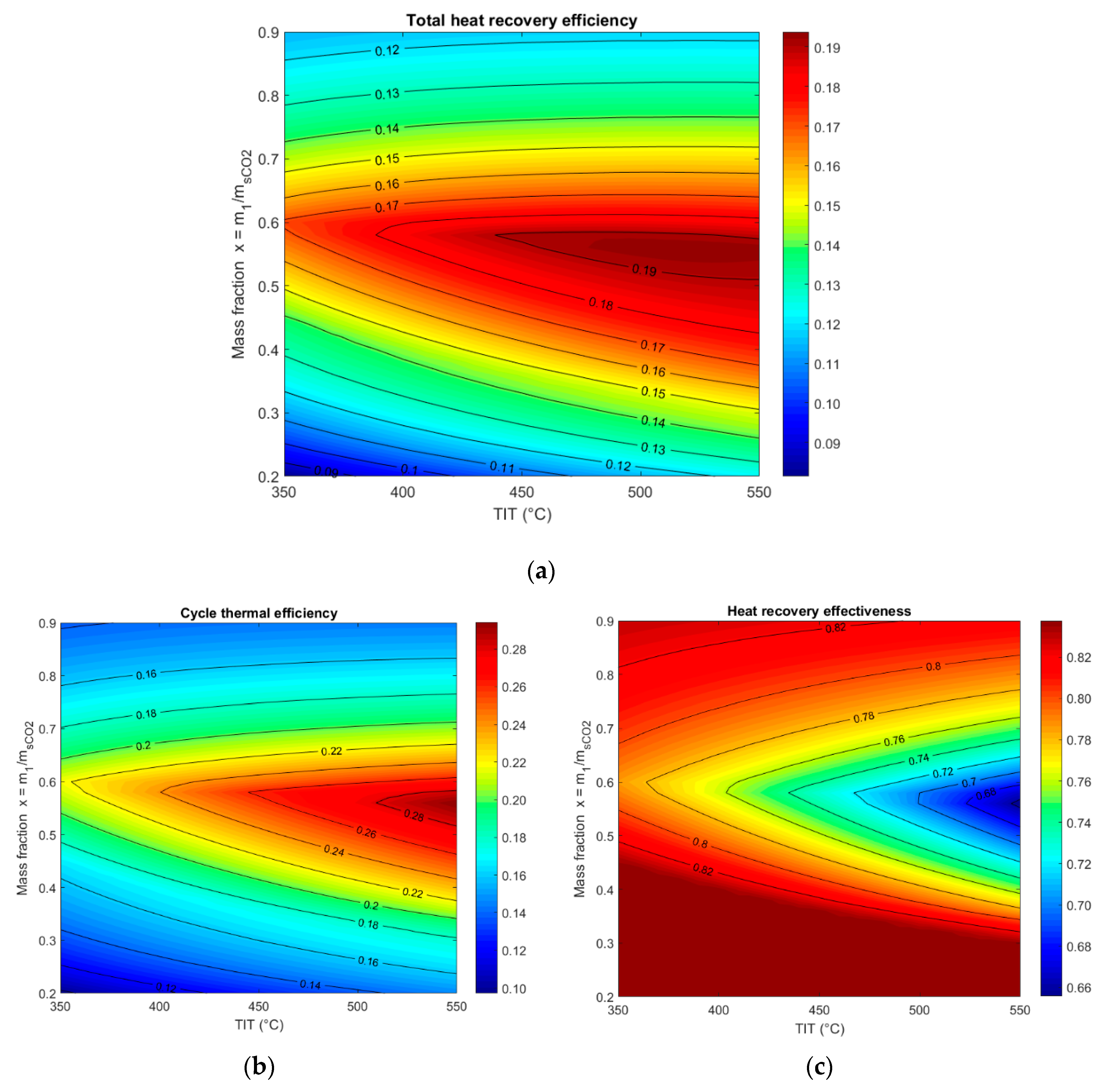
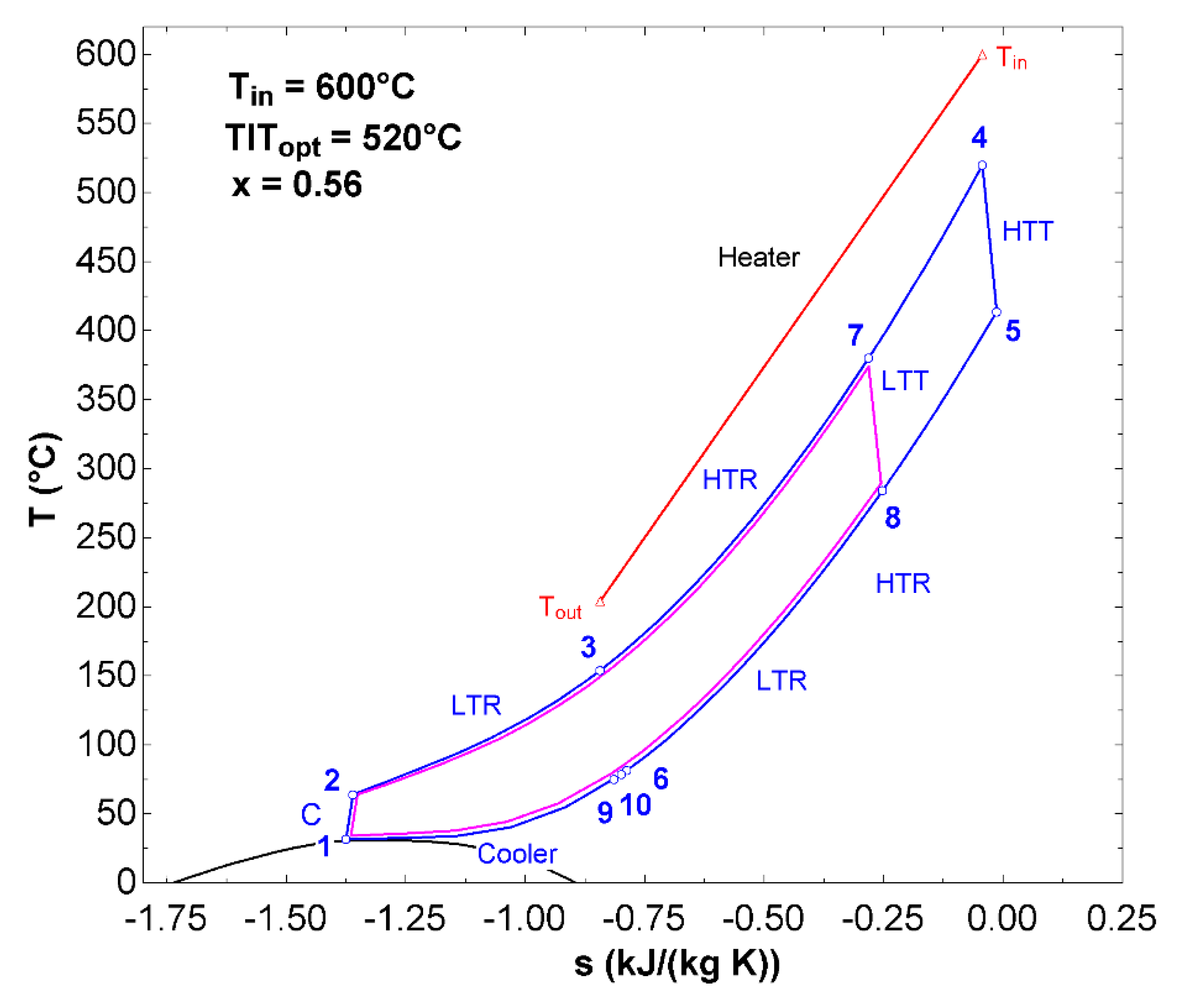

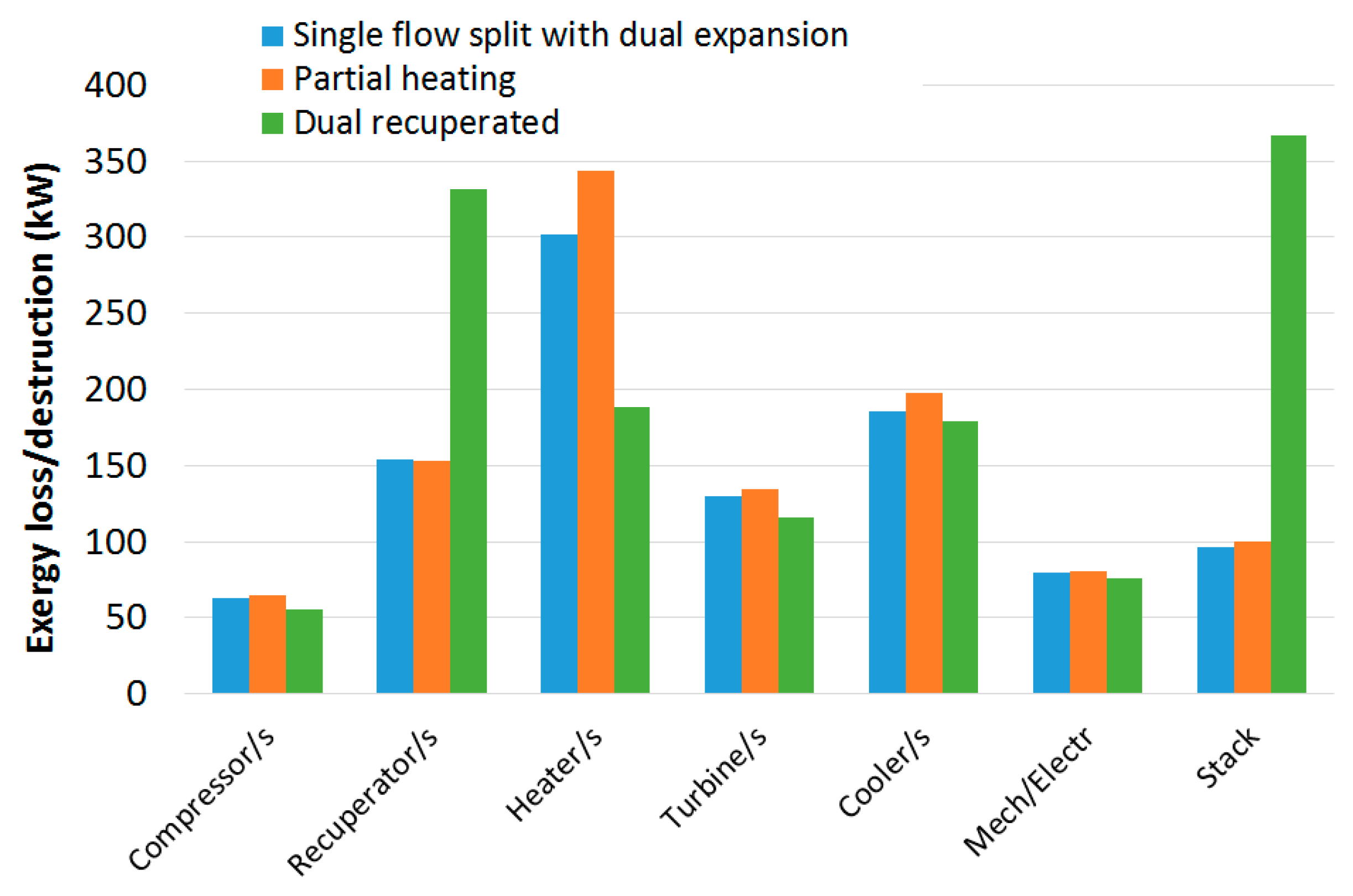
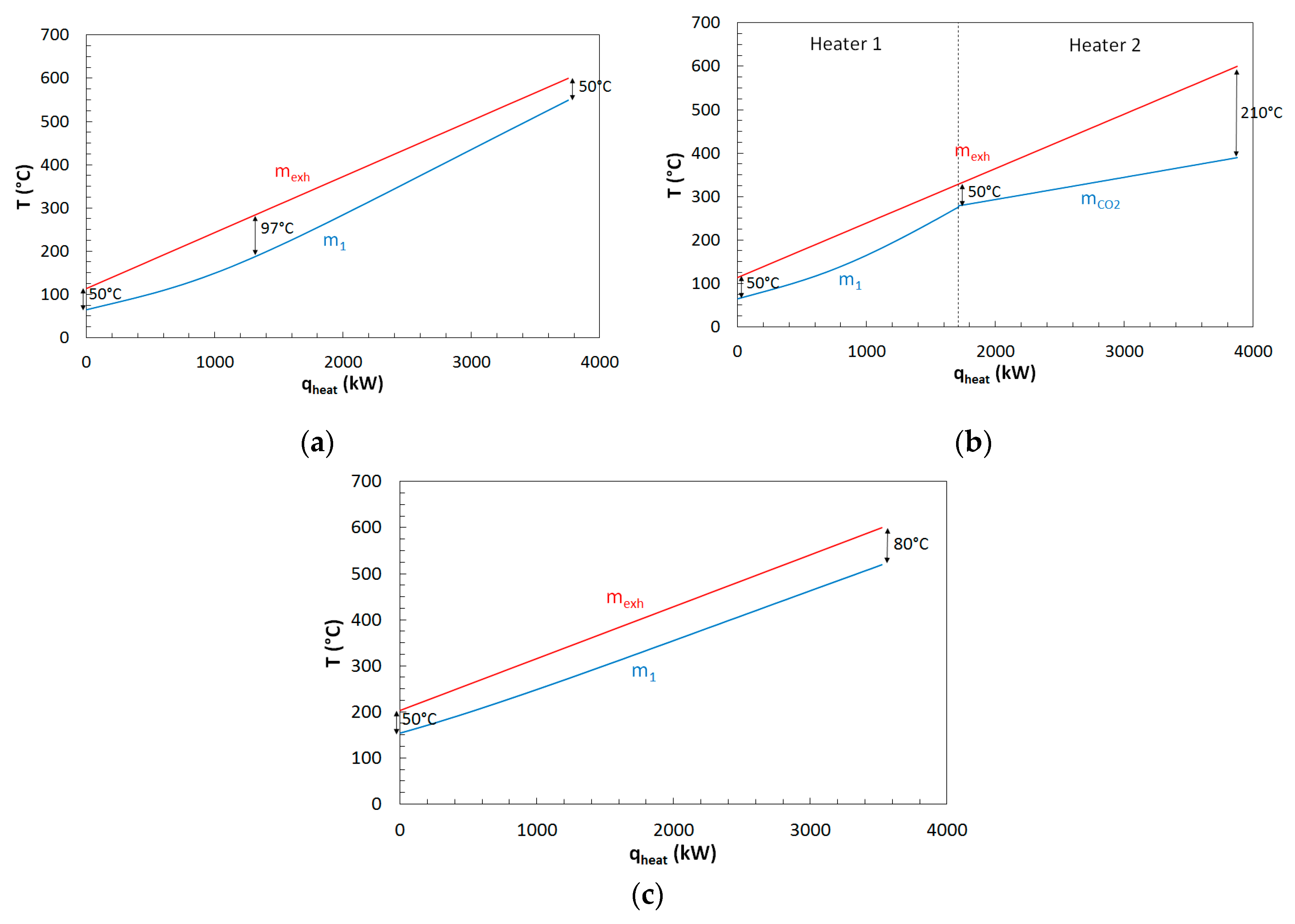

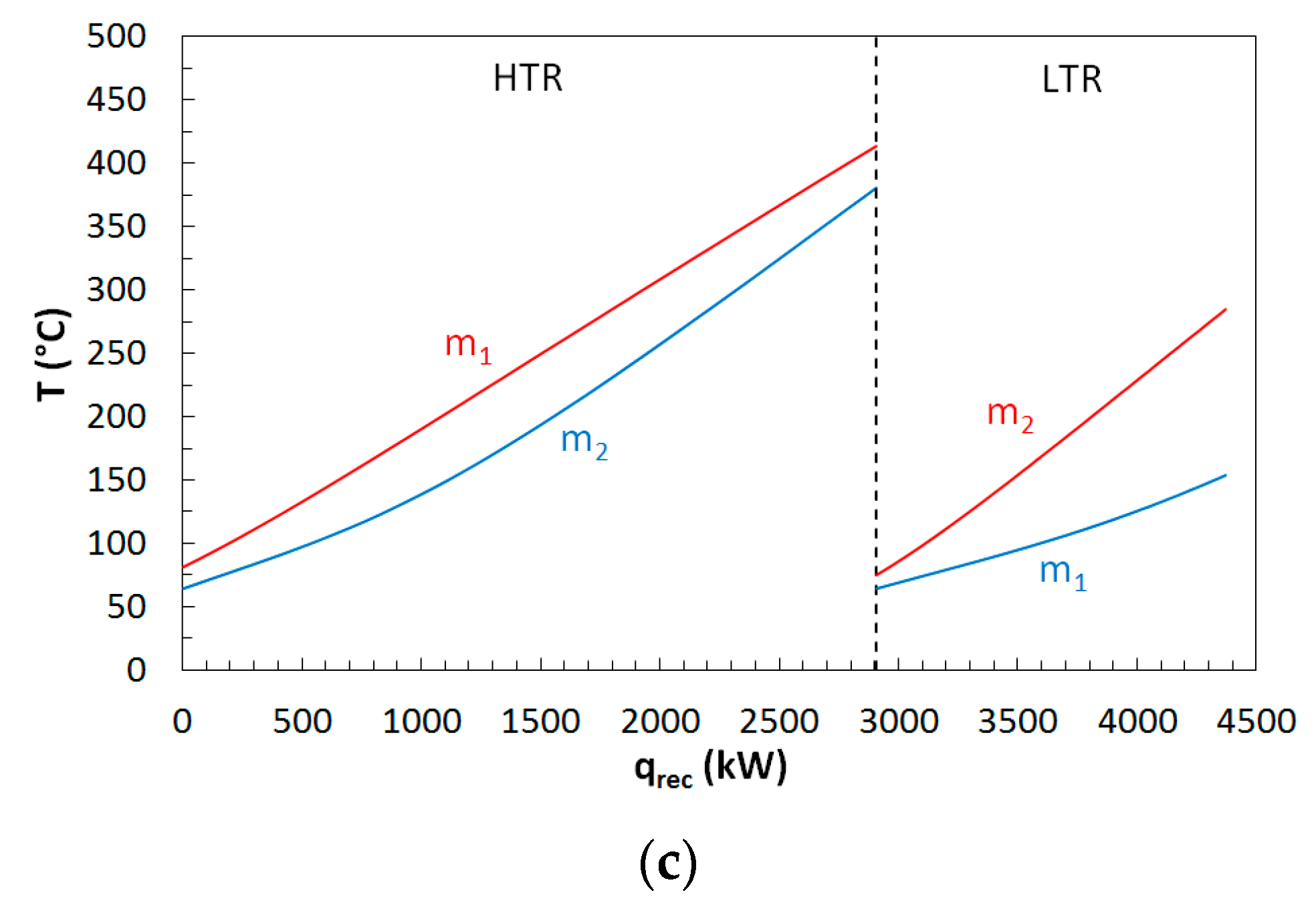
| Parameter | Value |
|---|---|
| Heat source inlet temperature, Tin (°C) | 600 |
| Heat source specific heat, cp (kJ/kg-K) | 1.17 |
| Ambient temperature, Tamb (°C) | 20 |
| Compressor inlet pressure, p1 (MPa) | 7.63 |
| Compressor inlet temperature, T1 (°C) | 32.0 |
| Maximum cycle pressure, p2 (MPa) | 20.0 |
| Recuperator/s effectiveness, ε (%) | 95.0 |
| Minimum temperature difference in the heater/s, ΔTmin (°C) | 50 |
| Pressure drops in recuperators and heaters, Δp (bar) | - |
| Isentropic efficiency turbine/s, ηis,T (%) | 85 |
| Isentropic efficiency compressor, ηis,C (%) | 80 |
| Mechanical/generator efficiency turbine/s, ηmg,T (%) | 95 |
| Mechanical efficiency compressor, ηm,C (%) | 98 |
| TIT | x | T2 | T4 | T5 | T6 | T7 | T8 | T9 | T10 | Tout | |||
|---|---|---|---|---|---|---|---|---|---|---|---|---|---|
| 550 1 | 0.35 1 | 22.30 | 26.62 | 83.77 | 64.1 | 441.4 | 236.2 | 225.4 | 324.9 | 232.7 | 233.9 | 73.8 | 114.1 |
| 500 | 0.30 | 14.18 | 16.93 | 83.77 | 64.1 | 395.3 | 80.7 | 64.1 | 131.9 | 55.3 | 62.1 | 62.1 | 114.1 |
| 500 | 0.50 | 18.76 | 22.39 | 83.77 | 64.1 | 395.3 | 274.5 | 268.2 | 379.2 | 283.3 | 278.9 | 124.6 | 114.1 |
| 400 | 0.40 | 16.33 | 19.50 | 83.77 | 64.1 | 302.6 | 106.2 | 95.9 | 178.3 | 95.5 | 99.7 | 65.9 | 114.1 |
| 400 | 0.60 | 15.76 | 18.82 | 83.77 | 64.1 | 302.6 | 244.1 | 221.4 | 298.6 | 208.0 | 229.7 | 128.0 | 114.1 |
| Parameter | Elementary Cycle 1 (Topping, Figure 2a) | Elementary Cycle 2 (Bottoming, Figure 2b) |
|---|---|---|
| Heat input from the external heat source (kW) | 3756 | - |
| Heat recovered from the exhaust of the first cycle (kW) | - | 2308 |
| Net power output (kW) | 477.3 | 522.7 |
| Thermal efficiency of elementary cycles (%) | 12.71 | 22.65 |
| TIT | x | T2 | T3 | T4 | T5 | T7 | T8 | Tinter | Tout | |||
|---|---|---|---|---|---|---|---|---|---|---|---|---|
| 390 1 | 0.30 1 | 21.63 | 25.82 | 83.77 | 64.1 | 276.0 | 280.1 | 278.9 | 293.3 | 75.6 | 328.9 | 114.1 |
| 400 | 0.50 | 16.79 | 20.05 | 83.77 | 64.1 | 169.1 | 290.7 | 227.2 | 302.6 | 135.0 | 277.2 | 114.1 |
| 400 | 0.10 | 16.69 | 26.23 | 63.62 | 64.1 | 225.1 | 225.1 | 225.1 | 302.6 | 76.1 | 275.1 | 231.0 |
| 500 | 0.30 | 16.11 | 27.46 | 58.67 | 64.1 | 378.7 | 378.7 | 378.7 | 395.3 | 97.8 | 428.7 | 259.7 |
| 300 | 0.30 | 18.02 | 21.52 | 83.77 | 64.1 | 133.3 | 185.0 | 168.3 | 209.3 | 71.4 | 218.3 | 114.1 |
| Parameter | Elementary Cycle 1 (Figure 4a) | Elementary Cycle 2 (Figure 4b) |
|---|---|---|
| Heat input from the external heat source (kW) | 2377 | 1496 |
| Heat recovered from the exhaust of the first cycle (kW) | - | 1215 |
| Net power output (kW) | 300 | 700 |
| Thermal efficiency of elementary cycles (%) | 12.62 | 25.82 |
| TIT | x | T2 | T3 | T5 | T6 | T7 | T8 | T9 | T10 | Tout | |||
|---|---|---|---|---|---|---|---|---|---|---|---|---|---|
| 520 1 | 0.56 1 | 19.39 | 28.40 | 68.27 | 64.1 | 154.0 | 413.7 | 81.6 | 380.4 | 284.4 | 75.2 | 78.7 | 204 |
| 500 | 0.40 | 16.77 | 21.38 | 78.43 | 64.1 | 95.1 | 395.3 | 80.7 | 186.7 | 103.2 | 66.1 | 71.7 | 145.1 |
| 500 | 0.70 | 15.45 | 20.20 | 76.51 | 64.1 | 106.3 | 395.3 | 210.3 | 378.7 | 282.8 | 75.1 | 166.8 | 156.3 |
| 400 | 0.40 | 14.26 | 17.05 | 83.63 | 64.1 | 65.0 | 302.6 | 76.1 | 143.9 | 65.0 | 64.2 | 68.8 | 115.0 |
| 400 | 0.70 | 15.07 | 19.03 | 79.20 | 64.1 | 90.7 | 302.6 | 158.2 | 290.7 | 200.6 | 71.0 | 129.8 | 140.7 |
| Parameter | Elementary Cycle 1 (Figure 6a) | Elementary Cycle 2 (Figure 6b) |
|---|---|---|
| Heat input from the external heat source (kW) | 3521 | - |
| Heat recovered from the exhaust of cycle 1 (kW) | - | 2905 |
| Net power output (kW) | 634.1 | 365.9 |
| Thermal efficiency of elementary cycles (%) | 18.01 | 12.60 |
| Parameter | Single Flow Split with Dual Expansion | Partial Heating | Dual Recuperated | Single Recuperated |
|---|---|---|---|---|
| Tin (°C) | 600 | 600 | 600 | 600 |
| x | 0.35 | 0.30 | 0.56 | - |
| TIT (°C) | 550 | 390 | 520 | 370 |
| 26.62 | 25.82 | 28.40 | 24.96 | |
| 83.77 | 83.77 | 68.27 | 63.40 | |
| 22.30 | 21.63 | 19.39 | 15.83 |
| Single Flow Split with Dual Expansion | Partial Heating | Dual Recuperated | |
|---|---|---|---|
| Waste heat source (kW) | 2010 | 2073 | 2312 |
| Net power (kW) | 1000 | 1000 | 1000 |
| Total exergy destruction/loss (kW) | 1010 | 1073 | 1312 |
| Exergy efficiency (%) | 49.75 | 48.24 | 43.24 |
| Single Flow Split with Dual Expansion | Partial Heating | Dual Recuperated | |
|---|---|---|---|
| Compressor | 63.1 | 64.8 | 55.3 |
| Recuperator | 153.7 67.4(HTR)/86.3(LTR) | 153.3 | 331.4 164.7(HTR)/166.7(LTR) |
| Heater | 302.0 | 343.3 166(HEATER1)/ 177.3(HEATER2) | 188.6 |
| Turbine | 130.0 46.8(HTT)/83.2(LTT) | 134.3 | 115.7 65.5(HTT)/50.3(LTT) |
| Cooler | 185.6 | 197.5 | 178.7 |
| Mixer | 0.03 | 0.04 | 0.24 |
| Mech/Electr | 79.5 | 80.2 | 76.1 |
| Stack | 96.7 | 99.7 | 366.5 |
| Total | 1010 | 1073 | 1312 |
© 2020 by the authors. Licensee MDPI, Basel, Switzerland. This article is an open access article distributed under the terms and conditions of the Creative Commons Attribution (CC BY) license (http://creativecommons.org/licenses/by/4.0/).
Share and Cite
Manente, G.; Costa, M. On the Conceptual Design of Novel Supercritical CO2 Power Cycles for Waste Heat Recovery. Energies 2020, 13, 370. https://doi.org/10.3390/en13020370
Manente G, Costa M. On the Conceptual Design of Novel Supercritical CO2 Power Cycles for Waste Heat Recovery. Energies. 2020; 13(2):370. https://doi.org/10.3390/en13020370
Chicago/Turabian StyleManente, Giovanni, and Mário Costa. 2020. "On the Conceptual Design of Novel Supercritical CO2 Power Cycles for Waste Heat Recovery" Energies 13, no. 2: 370. https://doi.org/10.3390/en13020370
APA StyleManente, G., & Costa, M. (2020). On the Conceptual Design of Novel Supercritical CO2 Power Cycles for Waste Heat Recovery. Energies, 13(2), 370. https://doi.org/10.3390/en13020370






